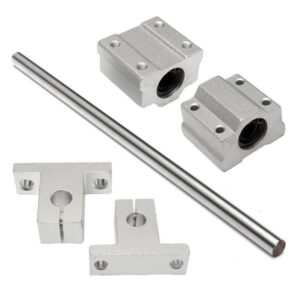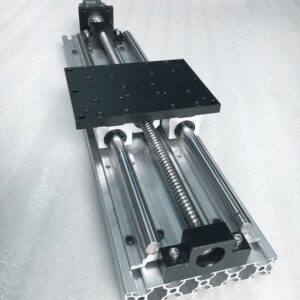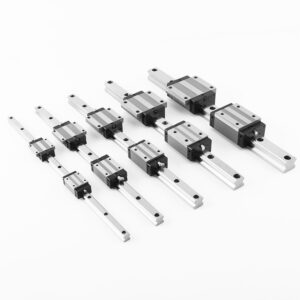Outline for “Linear Rail Types”
| Main Topic | Subtopics |
|---|---|
| Introduction to Linear Rail Types | Why they matter in precision engineering |
| What are Linear Rail Types? | Definition and classification |
| Importance of Linear Rail Types in Motion Systems | Role in CNC, robotics, automation |
| Basic Categories of Linear Rails | Profiled rails vs round rails |
| Profiled Linear Rails | Features, advantages, applications |
| Round Linear Rails | Features, advantages, applications |
| Ball Bearing Linear Rails | Low friction, high speed, use cases |
| Roller Bearing Linear Rails | Heavy load, rigidity, durability |
| Plain Linear Rails | Simplicity, cost-effectiveness |
| Miniature Linear Rails | Compact applications in electronics and medical devices |
| Heavy-Duty Linear Rails | Industrial machinery and automation |
| Self-Lubricating Linear Rails | Maintenance-free solutions |
| Modular Linear Rail Types | Customizable options for flexibility |
| Comparison of Linear Rail Types | Pros, cons, and performance |
| Applications of Different Linear Rail Types | CNC, 3D printing, packaging, robotics |
| Factors to Consider When Choosing Linear Rail Types | Load, speed, environment |
| Installation Best Practices for Linear Rails | Accuracy, alignment, mounting |
| Common Problems with Linear Rail Types | Misalignment, wear, contamination |
| Maintenance Tips for Different Linear Rail Types | Cleaning, lubrication, inspection |
| Future Trends in Linear Rail Types | Smart rails, IoT monitoring |
| Frequently Asked Questions about Linear Rail Types | Six FAQs with answers |
| Conclusion | Summary and expert insights |
Introduction to Linear Rail Types
In the fast-paced world of precision engineering, the type of linear rail you choose can significantly affect your machine’s performance, accuracy, and durability. Whether it’s CNC machining, robotics, or advanced automation, the right linear rail type ensures smooth, friction-free motion. With so many variations available, it’s important to understand their differences before making an investment.
This guide dives deep into the world of linear rail types, exploring their design, strengths, limitations, and real-world applications.
What are Linear Rail Types?
Linear rail types refer to the various designs of linear motion systems that guide machines along a straight path. Each type is tailored for specific requirements, balancing factors like load capacity, accuracy, rigidity, and cost.
In general, all linear rails consist of:
Rail (track): Provides a path for movement.
Carriage (block): Slides or rolls along the rail.
Rolling/Sliding elements: Balls, rollers, or plain surfaces.
Different rail types use unique mechanisms to reduce friction and handle loads efficiently.
Importance of Linear Rail Types in Motion Systems
The choice of rail type directly impacts:
Machine accuracy and repeatability
Speed and efficiency
Maintenance requirements
Durability under stress
From lightweight 3D printers to massive CNC milling machines, every application demands a specific rail type.
Basic Categories of Linear Rails
Broadly, linear rail types are classified into:
Profiled Linear Rails (Square Rails): High precision, rigidity, and accuracy.
Round Linear Rails: Simpler, cost-effective, and tolerant of misalignment.
From these two categories, specialized designs emerge to suit different industries.
Profiled Linear Rails
Profiled or square rails are the gold standard in CNC and automation systems.
Features:
Rectangular cross-section.
High stiffness and accuracy.
Uses recirculating ball or roller bearings.
Applications: CNC machining centers, robotics, semiconductor equipment.
Round Linear Rails
Round rails are simpler and easier to install.
Features:
Circular cross-section.
Less rigid but more forgiving of misalignment.
Cheaper and easier to maintain.
Applications: Packaging machines, light-duty automation, medical devices.
Ball Bearing Linear Rails
These rails use rolling ball elements for movement.
Advantages:
Very low friction.
High speed and smooth motion.
Applications: 3D printing, precision measurement, small CNC machines.
Roller Bearing Linear Rails
Instead of balls, these rails use rollers for load support.
Advantages:
Higher load capacity.
Excellent rigidity.
Longer lifespan.
Applications: Heavy-duty CNC, aerospace, automotive industry.
Plain Linear Rails
These are the most basic rail types, without rolling elements.
Advantages:
Cost-effective.
Maintenance-free.
Suitable for dirty environments.
Applications: Woodworking, heavy construction machinery.
Miniature Linear Rails
Compact rails designed for small, precise movements.
Applications: Electronics, robotics, medical imaging equipment.
Heavy-Duty Linear Rails
Built to withstand extreme loads and harsh conditions.
Applications: Mining, steel production, large CNC machines.
Self-Lubricating Linear Rails
These rails feature built-in lubrication systems.
Advantages:
Reduced maintenance.
Longer operating life.
Applications: Automated production lines, cleanrooms.
Modular Linear Rail Types
Modular systems allow custom configuration.
Advantages:
Flexibility in design.
Easy integration with existing systems.
Applications: Custom automation, research labs.
Comparison of Linear Rail Types
| Type | Precision | Load Capacity | Cost | Best For |
|---|---|---|---|---|
| Profiled Rails | High | High | $$$ | CNC, robotics |
| Round Rails | Medium | Medium | $$ | Packaging, automation |
| Ball Bearing Rails | Very High | Medium | $$$ | 3D printing, light CNC |
| Roller Bearing Rails | High | Very High | $$$$ | Heavy CNC, aerospace |
| Plain Rails | Low | High | $ | Harsh environments |
| Miniature Rails | High | Low | $$ | Electronics, medical |
| Self-Lubricating | High | Medium | $$$ | Clean automation |
Applications of Different Linear Rail Types
CNC Machines: Profiled and roller rails.
3D Printers: Ball bearing rails.
Robotics: Miniature and profiled rails.
Packaging Industry: Round rails.
Heavy Machinery: Plain and heavy-duty rails.
Factors to Consider When Choosing Linear Rail Types
Load requirements
Desired precision
Operating environment
Budget and maintenance needs
Installation Best Practices for Linear Rails
Ensure proper alignment.
Use correct mounting hardware.
Apply lubrication during assembly.
Avoid over-tightening bolts.
Common Problems with Linear Rail Types
Misalignment leading to uneven wear.
Dust and debris contamination.
Lack of lubrication causing noise.
Overloading reducing lifespan.
Maintenance Tips for Different Linear Rail Types
Clean rails regularly.
Reapply lubrication at intervals.
Inspect for wear and replace early.
Use protective covers when possible.
Future Trends in Linear Rail Types
Smart rails with embedded sensors.
IoT integration for predictive maintenance.
Lightweight composite materials for efficiency.
Eco-friendly lubrication systems.
Frequently Asked Questions about Linear Rail Types
What are the two main types of linear rails?
Profiled (square) rails and round rails.
Which linear rail type is best for CNC machines?
Profiled or roller-bearing rails for precision and load handling.
Are round rails less accurate than square rails?
Yes, but they are more forgiving of misalignment and cheaper.
Do linear rails need lubrication?
Yes, most types require regular lubrication, except self-lubricating ones.
Can I use miniature rails for heavy loads?
No, they are designed for small, precise applications only.
What is the most durable linear rail type?
Roller-bearing and heavy-duty profiled rails last longest under high stress.
Conclusion
Choosing the right linear rail types is crucial for ensuring accuracy, durability, and performance in your machinery. From lightweight miniature rails for electronics to heavy-duty profiled rails for CNC machining, each type has unique advantages. By understanding their strengths, weaknesses, and applications, you can make informed decisions that enhance efficiency and reduce long-term costs.




